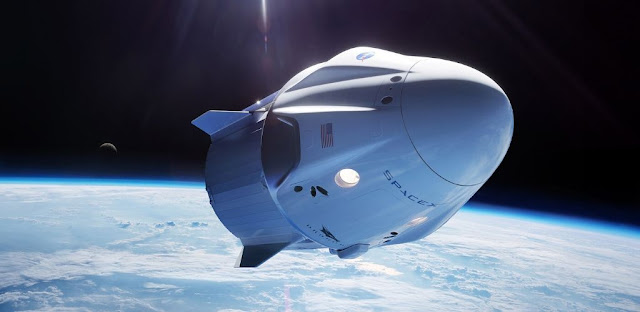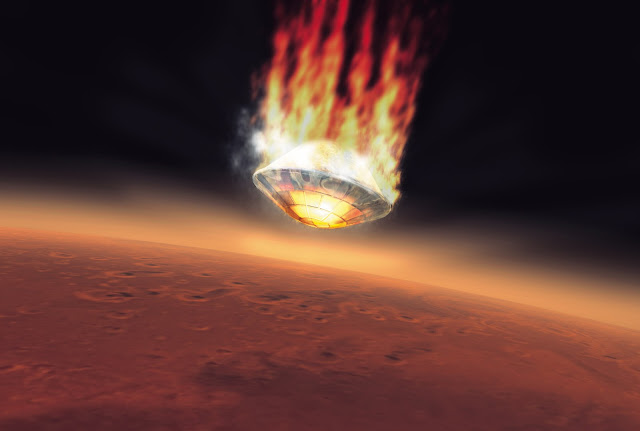Spacecrafts and Heat-Shields go hand-in-hand. A heat shield is a barrier that protects a spacecraft from the intense heat of friction as it enters a planet's atmosphere. Without a heat shield, a spacecraft would be quickly destroyed.
There are two types of heat shields: ablative and non-ablative. Ablative heat shields work by slowly burning up as they protect the spacecraft. Non-ablative heat shields work by deflecting the heat away from the spacecraft.
A heat shield is made up of several layers. The first layer is the thermal protection system (TPS). The TPS protects the spacecraft from the heat of friction by absorbing it. The next layer is the structural layer. This layer provides support for the heat shield. The last layer is the ablative layer. This layer slowly burns away, taking the heat with it.
Heat shields are essential for any spacecraft that plans to enter a planet's atmosphere. Without one, the spacecraft would burn and will burst.
☬ What Is A Spacecraft ?
A spacecraft is a vehicle or machine designed for operation in space. Spacecraft are used for a variety of purposes, including communications, earth observation, meteorology, navigation, planetary exploration and transportation of humans and cargo.
Spacecraft are built to withstand the harsh environment of space, which includes extreme temperatures, vacuum and radiation. They are also equipped with propulsion systems to enable them to navigate through space.
Spacecraft are launched into space by rockets and are operated by ground controllers. They are typically designed to operate for a specific mission and then are decommissioned after their mission is complete.
☬ What Is Heat Shield To A Spacecraft ?
A heat shield is a system designed to protect a spacecraft from the heat of atmospheric reentry. The heat shield is the first line of defense against the heat of reentry and is typically the only system required to protect the spacecraft from the environment.
A heat shield typically consists of a ablative material, a material that ablates or burns away during reentry, and a radiation shield. The ablative material is the primary heat-protection system and is designed to protect the underlying structure of the spacecraft. The radiation shield protects the spacecraft from the intense heat and radiation of reentry and is typically composed of a reflective material.
The heat shield is a critical component of a spacecraft and must be carefully designed and tested to ensure the safety of the spacecraft and its crew.
☬ History Of Space Exploration
In the early days of space exploration, the only way to get into space was by being shot out of a cannon. This was first done in the early 1800's by Sir Isaac Newton. He proved that it was possible to get into space this way, but it was not very practical.
In the early 1900's, a scientist named Robert Goddard built the first rocket that could actually fly into space. This was a huge breakthrough, and it led to the development of the space program.
The first human being to go into space was Yuri Gagarin. He was a Russian cosmonaut and he made a single orbit around the Earth in 1961. This was an incredible accomplishment, and it showed that humans could survive in space.
Since then, humans have continued to explore space. We have sent people to the Moon, and we have sent probes to Mars and beyond. Space exploration is an ongoing process, and we are constantly learning new things about our universe.
☬ Importance Of Heat Shield To A Spacecraft
A spacecraft is designed to operate in a very hostile environment – the vacuum of space. In order to protect the astronauts and sensitive equipment on board, the spacecraft must be equipped with a heat shield.
The heat shield protects the spacecraft from the extreme temperatures that it encounters during its journey. It is made of materials that can withstand high temperatures and is designed to dissipate the heat away from the spacecraft.
Without a heat shield, the spacecraft would be damaged by the heat and the astronauts would be at risk of being injured or killed. The heat shield is essential for the safety of the spacecraft and its crew.
☬ The Technology And Design Of Spacecrafts Heat-Shields
Spacecraft heat shields are one of the most important pieces of technology when it comes to space travel. Without a heat shield, a spacecraft would be quickly destroyed when entering a planet's atmosphere. Heat shields work by absorbing and dissipating the heat that is generated when a spacecraft is travelling at high speeds. There are many different types of heat shields, each of which is designed for a specific purpose. For example, some heat shields are designed to protect a spacecraft from the heat generated by friction, while others are designed to protect against the heat generated by the sun.
One of the most important factors in the design of a heat shield is the material that it is made from. The material must be able to withstand the high temperatures that are generated during space travel. There are many different materials that can be used for heat shields, but one of the most common is a type of ceramic called alumina. Alumina is a very good heat conductor, which means that it can dissipate heat quickly.
☬ Can Spacecrafts Return To Earth Without Heat-Shields?
Yes, in principle. However, this may not be practical or desirable. HeatShield is essential for spacecrafts to return to Earth safely and without damage. Without it, the spacecraft may enter the atmosphere at a high speed and could be destroyed. Alternatively, it may be sent into orbit around the Earth, but would not be able to land on the surface.
☬ What Would Happen If a Spacecraft Returned To Earth Without A Heat Shield?
As we all know, when spacecrafts return to Earth, they experience intense heat and friction due to the atmosphere. This heat can cause serious damage to the spacecraft and its components. In order to protect the spacecraft, engineers design and build heat shields.
Heat shields are made of materials that can withstand high temperatures, such as carbon fiber or ceramic. They are attached to the spacecraft in order to protect it from the heat and friction of reentry.
However, there are some cases where spacecrafts have returned to Earth without heat shields. For example, the Space Shuttle Columbia disintegrated upon reentry in 2003. The cause of the accident was a piece of foam that broke off from the fuel tank and damaged the heat shield.
In another example, the Russian space station Mir was damaged during reentry in 2001. The heat shield was damaged and the station began to break apart. However, the crew was able to safely land the station before it completely disintegrated.
☬ Causes Of Spacecrafts Heat-Shield's Failure
There is no one-size-fits-all answer to the question of why spacecraft heat shields fail. Each incident is unique and must be analyzed on a case-by-case basis. However, there are some common factors that can lead to heat shield failure.
One of the most common causes of heat shield failure is poor design. The heat shield is one of the most critical components of a spacecraft, and it must be designed to withstand the extreme temperatures and pressures of atmospheric reentry. If the heat shield is not designed properly, it can fail to protect the spacecraft from the intense heat and pressure, leading to catastrophic results.
Another common cause of heat shield failure is manufacturing defects. Even the best-designed heat shield can be rendered useless if it contains defects that cause it to fail during reentry.
Finally, heat shield failure can also be caused by operational errors. For example, if a spacecraft is not oriented correctly during reentry, the heat shield can be exposed to more.
☬ Potential Concequences of Spacecrafts Heat Shield
As space missions become longer and more ambitious, the potential consequences of a malfunctioning heat shield become more severe. A heat shield is designed to protect a spacecraft and its occupants from the extreme temperatures of reentry, but if it fails, the results could be catastrophic.
If a heat shield fails during reentry, the consequences depend on how bad the failure is. A small breach might cause only localized damage, while a complete failure could lead to the destruction of the spacecraft. The most likely scenario, however, is somewhere in between.
If a heat shield fails, the first thing that will happen is that the spacecraft will start to heat up. This can cause all sorts of problems, from melting the insulation to causing the electronics to malfunction. If the heat build-up is severe enough, it could even cause the structure of the spacecraft to start to fail.
Once the heat shield fails, there is nothing to stop the heat from continuing to build up. This can cause the spacecraft to burst in the atmosphere.
☬ Conclusion : What Can Be Done to Prevent The Failure Of Spacecrafts Heat-Shields ?
As the space environment is incredibly hostile, spacecraft must be designed to withstand extreme temperatures and protect their occupants. One of the most crucial components of a spacecraft is the heat shield, which protects the craft from the intense heat generated when reentering the atmosphere.
Despite their importance, heat shields are notoriously finicky and have failed on multiple occasions. In order to prevent future failures, engineers must understand the root causes of past failures and design new heat shields with those lessons in mind.
One of the most common causes of heat shield failure is improper installation. Heat shields must be installed very carefully in order to work correctly. If even one small component is not installed correctly, the entire system can fail.
Another cause of heat shield failure is material degradation. Over time, the materials used in heat shields can break down and become less effective. This is why it is important to regularly inspect and maintain heat shields.













